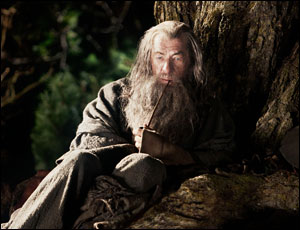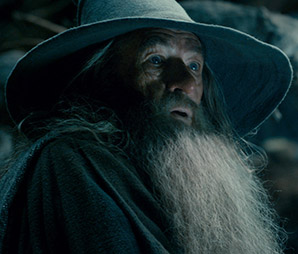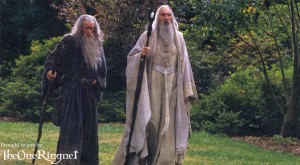 In our latest Library feature, Tedoras muses on how we can view Gandalf as the prime extension of the will of J.R.R. Tolkien within The Lord of Rings.
In our latest Library feature, Tedoras muses on how we can view Gandalf as the prime extension of the will of J.R.R. Tolkien within The Lord of Rings.
Gandalf as Tolkien’s Will
By Tedoras
“Hobbits really are amazing creatures,” a wise man once remarked. While Gandalf was indeed right about that, it is a rather fatuous comment for such a sage to make. The praises of the halflings are sung perpetually in our fandom, as they rightfully are affirmed by their deeds in the legendarium. But it is certainly time we reexamined our relationship with Gandalf — for here, truly, is an amazing creature.
We are all familiar with the ways Gandalf is a shaper and mover on a (theoretically) massive though (physically) small scale: he pushes the right hobbits out of doors at just the right time, and in doing so changes the course of the world for the better. Gandalf’s sagacity and providence certainly merit much praise. But I have already written on Gandalf’s nature in shaping the events of the Third Age
This side, the oft-examined side, focuses on Gandalf’s entextualized persona and relationships; here, we are used to defining him as the archetypal “mentor/guardian/wise old man.”
While this archetype allows us to examine the works internally, we must use another archetypal lens to analyze the text from an external point of view, even from the author’s very own.
In my research, I have not found any suitable characterization of this archetype, but I have come to define it as the “voluntas scriptoris/creatoris,” the “will of the author/creator.” (I find “voluntas creatoris” particularly preferable in the context of mythopoeic fantasy, where the author is the creator of the world.)
When we read Tolkien’s works defining Gandalf simply as the “mentor,” I argue, we see only half of his greatness — and the amazing quality about him is that this half, just one half, is filled with such wondrous amazement in skill and wit and wisdom.
But when we read the texts defining Gandalf as the “voluntas creatoris,” we are opened up to an entirely new realm of exploration, one that shows even more so the existential importance and (perhaps) cosmic nature of this much-beloved character. Only when we note this duality in Gandalf’s character can we give praise where praise is due. And no offence to hobbits, men, or any other actors in the Third Age, but I am here to champion Gandalf.
 Mithrandir, Olórin, Tharkûn, Incánus, Stormcrow — whatever you wish to call him, let’s all, every denizen of Middle-earth, come together and give a proper “thank you” to one who, ever so deserving, has never asked for it.
Mithrandir, Olórin, Tharkûn, Incánus, Stormcrow — whatever you wish to call him, let’s all, every denizen of Middle-earth, come together and give a proper “thank you” to one who, ever so deserving, has never asked for it.
When reading The Lord of the Rings or The Hobbit, we naturally do so as the “intended reader,” or specific “audience,” for whom Tolkien was writing. Through such a reading, we are easily drawn to the notion of Gandalf as the archetypal “mentor,” “guardian,” or “wise old man.” The problem with these archetypes nowadays is that they lend themselves to esoteric, stale, and platitudinous studies of a vastly more colorful, enigmatic, and amazing character.
The inclusion of the “mentor” archetype is evidently axiomatic in mythopoeic literature, and is one we as Tolkienites encounter in many of our favorite works from numerous authors across time. And we know that this archetype denotes an entextualized relationship; it, thus, leads generally to an examination of the relationship between the “mentor” and protagonist, if not other archetypes in the cast.
Let me lay it all out more explicitly.
The importance of the “mentor” archetype lies in that character’s link with the protagonist; but, the importance of the “voluntas creatoris” lies in its link with the author. Before going on, I must also address the issue of dichotomy, for it is an integral part of the latter archetype. The “voluntas creatoris” is at once realized as himself and another, distinct archetype (though often this is just the “mentor”). Not surprisingly, Gandalf’s role in the legendarium exemplifies this dichotomy.
However, by studying Gandalf’s relationship with other characters, we only see one side of the coin. The other side is one we do not often examine, let alone consider, when we read works of literature because we are taught in school to ignore it. It requires us to read more introspectively from the author’s own point of view; that is, it requires us to examine the text not as the “intended reader,” but as the author. We must remove ourselves from the story for a while and learn to look at the events, words, and characters used as what they inherently are — choices.
You may be wondering how I settled on the name “creator’s will” for this archetypal role. By now, however, I’m sure you have a number of reasons and guesses as to why.
Yes, this archetype is the embodiment of the creator’s will, wants, and desires. But much more specifically than that, we often find in fantasy literature that this character exists to ensure what the author desires ultimately comes about; in most cases, this is to ensure that good does triumph over evil, and that bonds of love, friendship, and courage rule the day. I’m sure that a number of such characters come to mind at this description. However, in the context of Tolkien — or at least the works of the Third Age — none rivals Gandalf in this role.
 Moreover, we can distinguish Gandalf from almost any other character in all of the legendarium as the major “voluntas creatoris.” Certainly, as an Istari, Gandalf shares many traits with the four other wizards sent by Manwe to Middle-earth. However, we can plainly discount two of these (the Blue), and Radagast (since he is barely mentioned). We are left with Saruman and Gandalf. What distinguishes Gandalf from Saruman, however, is a sense of fear. It may be odd to associate such power with fear, but even from the very beginning, when Manwe first asked him to go East, Gandalf exhibited a rational sense of fear of his enemy.
Moreover, we can distinguish Gandalf from almost any other character in all of the legendarium as the major “voluntas creatoris.” Certainly, as an Istari, Gandalf shares many traits with the four other wizards sent by Manwe to Middle-earth. However, we can plainly discount two of these (the Blue), and Radagast (since he is barely mentioned). We are left with Saruman and Gandalf. What distinguishes Gandalf from Saruman, however, is a sense of fear. It may be odd to associate such power with fear, but even from the very beginning, when Manwe first asked him to go East, Gandalf exhibited a rational sense of fear of his enemy.
Tolkien takes this sense of fear to heart in his crafting of Gandalf’s persona; with this fear always present — not an overwhelming, consuming fear, as perhaps may have caused Saruman’s treachery — Gandalf has been able to craft calculated responses to all the problems he has faced. That is, fear has been a motivator for Gandalf, and it has set him to do things that would, ultimately, alleviate itself.
Beyond this sense of fear, however, there is a myriad of powerful “shapers” and “movers” in Middle-earth lore who could perhaps contend for the title of “voluntas creatoris.” What distinguishes Gandalf from any of them?
First, Gandalf was sent to Middle-earth with a mission. This means that his outlook remains fundamentally different from other inhabitants of those lands. For Gandalf, he is constantly motivated by his Valar-determined goals; he is never really troubled by the web of personal matters that engirth so many of Middle-earth’s native-born finest. And though many others have had the same goal as Gandalf, and have striven equally valiantly to defeat darkness and evil, one explicit event in his life distinguishes his importance: his return from death.
As many know, Gandalf used his last strength to defeat the Balrog Durin’s Bane — all in the name of continuing his quest and saving the Fellowship. Thus, when his spirit left his body, he having ‘died’ still faithfully devoted to his task, Eru sent him back. Tolkien’s, or Eru’s, explicit saving of Gandalf — their request that he return until his job is done — highlights the true importance of this specific character.
Thus, we begin to paint a portrait of Gandalf rooted in intentionality, both of existence and design, towards Tolkien’s will. What exactly is that will and desire, specific to these texts?


